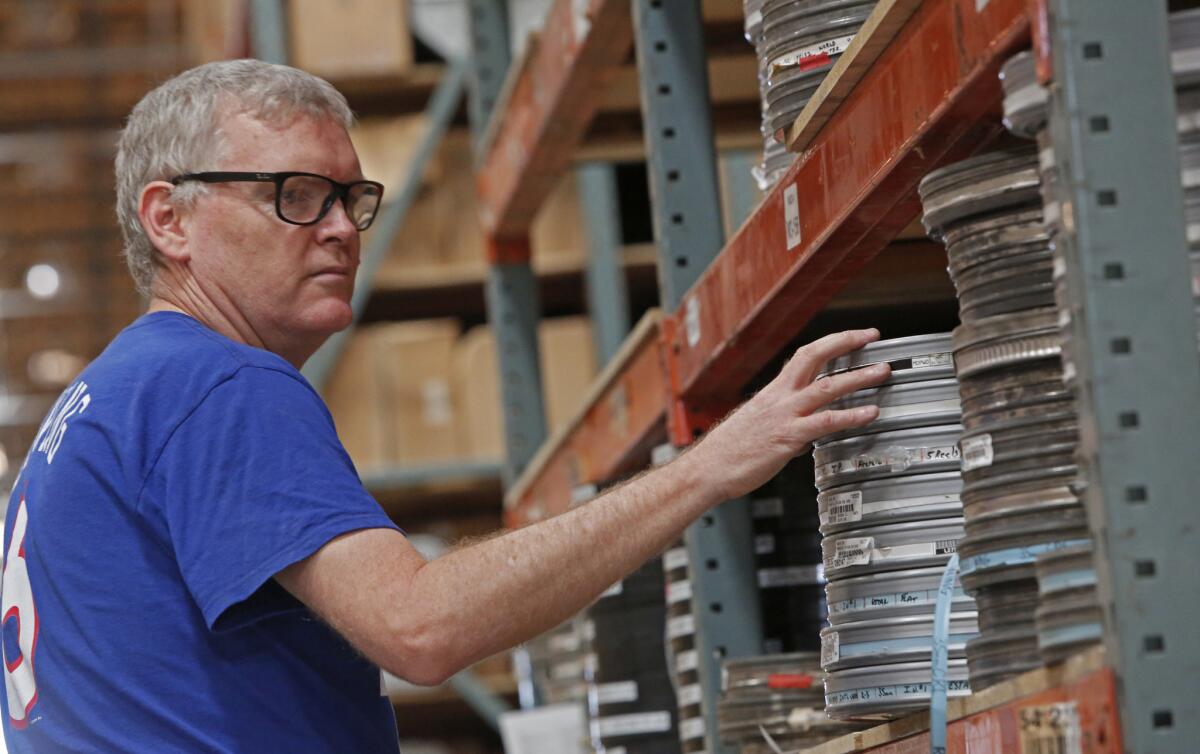Great Read: A painstaking effort to reunite forgotten films with their owners

Ed Carter from the Academy of Motion Picture Arts and Sciences sorts through old film prints from Deluxe Film in a warehouse in Lebec. Once sorted they will be sent to the Academy in Hollywood. (Anne Cusack/Los Angeles Times)
- Share via
Reporting from LEBEC, Calif. — Inside a 260,000-square-foot warehouse just over the Grapevine off Interstate 5, an archivist from the Academy of Motion Picture Arts & Sciences clambered up a ladder to inspect a stack of dusty 35-millimeter film cans.
“What are some of the titles we’re looking for?” he shouted over the din of beeping forklifts and clacking metal.
“‘The Wacky Playboy,’ ‘Two Bits,’ ‘Twenty Bucks,’ ‘Scalper,’” replied a colleague, who was scanning a list on a yellow notepad.
The man on the ladder pulled several silver-colored canisters off the shelf and plunked them on a pallet that would later be shrink-wrapped and loaded onto a truck for delivery to the academy’s film archive.
By the end of the day, some 5,000 cans of film would find a new home at the academy.
That left just 40,000 cans to go in the mission to rescue Hollywood’s “orphan films” — movies abandoned by producers or the companies that financed them.
Patiently watching over the operation was Greg Lea, a cheerful native of west London and fervent film historian. He and his colleagues at Deluxe Entertainment Services Group have spent the last two years trying to return the forgotten films, some dating back half a century, to their rightful owners. Most are art house or independent films that never made it to the big leagues.
“This is 20th century American history, so you don’t want it to be lost,” Lea said. “It may be someone’s dream that didn’t get abandoned, but they couldn’t afford to move the project any further. When you’ve got someone’s dreams, you don’t want to end up throwing them in the trash can.”
The end of film is a dramatic story in Hollywood. Paramount made headlines last year when it told exhibitors it would release virtually all future movies digitally. Most theaters around the country have invested millions to ditch their film projectors and install digital systems.
Slackening demand for film prints prompted Deluxe and Technicolor to close their film labs, laying off hundreds of workers. Fujifilm Corp. has exited the movie film business, leaving Eastman Kodak as the sole remaining major supplier of film stock. Kodak filed for bankruptcy protection in 2012, though several studios have banded together to keep the company’s film business alive.
Although digital technology enables studios to distribute movies much more cheaply than film, not everyone is happy about film’s pending demise. Prominent directors, including Christopher Nolan and Quentin Tarantino, have opposed the relentless march to digital formats, contending the medium is inferior to 35-millimeter film.
But there is a more fundamental question: When Hollywood goes all digital, what happens to the film legacy left behind?
It’s not an idle question. The original negatives of some 90% of the films made between 1901 and 1929 no longer exist. The same nearly happened in the 1970s when studios decided to divest themselves of nitrate film, which was used before 1950 and was highly flammable.
For the last two years, Deluxe has worked closely with the major studios and others to ensure that tens of thousands of film negatives were rightfully claimed.
But many more are orphans — produced by companies that either forgot about them, went out of business or no long wanted to pay to keep them in storage facilities like the one in Lebec.
“Some companies make a decision that they don’t really want it anymore,” Lea said. “It’s somebody else’s problem. You can understand it. But for those of us who want to preserve the film history, it’s the wrong decision.”
Lea’s official title is asset relocation specialist, but he’s as much detective as film archivist and data miner. His job is to find the owners of the mystery negatives and follow any leads he can to track them down. (It’s not pure altruism: Deluxe could benefit by having owners pay to create digital copies from the film negatives.)
It’s no easy task, given the fickle nature of the movie businesses. Many films financed by hedge funds sold the distribution rights to other funds, much like mortgages are sold to third parties. What’s more, once prolific producers of independent films are no longer around to claim their property.
“These are movies that were parts of studios that flew too close to the sun and whose Icarus project came crashing down,” Lea said.
At his office in Hollywood, the 47-year-old Lea starts the process by poring over records from the former film lab, scanning letters and agreements of Deluxe’s clients.
He reviews the documents with help from a legal team at Deluxe to find clues as to who produced the movie and who acquired the rights. He consults archivists at the major studios and uses other industry sources, such as the online industry database IMDB.
Lea also has been working closely with the academy, as well as various nonprofit groups including UCLA Archives, the Sundance Institute and IndieCollect.
The academy has so far selected about 1,000 titles from the Deluxe collection to conserve in its film archive vaults, at least until someone claims them. Archivists selected movies that involved Oscar nominees or made a significant contribution to their genre, said Michael Pogorzelski, director of the Academy Film Archive.
“Our mission is to preserve cinema history, and the primary way we’re going to be doing that over the next three years during the latter part of the digital transition is by physically collecting these films and keeping them safe,” Pogorzelski said.
Among the films chosen by the academy were “The Limey,” a 1999 thriller about a British ex-con who comes to L.A., directed by Steven Soderbergh and starring Peter Fonda; and “Give ‘em Hell, Harry!” a 1975 movie about former U.S. President Harry S. Truman that was nominated for an Oscar.
In addition to documentaries and student films, many of the titles are B-horror movies or grindhouse films with titles including “House of Evil,” a 1968 horror film starring Boris Karloff; “Flesh Suitcase,” a 1995 thriller about drug mules who carry drugs in their stomachs; and “Adios Amigo,” a 1976 blaxploitation cowboy movie starring Richard Pryor and Fred Williamson. One of the more unusual titles is the surreal cult western “Greaser’s Palace,” a 1972 parable of the life of Christ written and directed by Robert Downey Sr.
Some may have surfaced in a film festival years ago but had short theatrical runs. Others never made it into theaters.
No matter how obscure, Lea and his colleagues talk about each film with reverence.
“Every title is a different story,” Lea said. “That’s the whole gist of this, to make sure these are preserved.”
Sometimes, Lea gets lucky.
One of his success stories is a 1974 cult film called “It Happened One Weekend,” the life’s work of a Texas musician-turned-filmmaker named Palmer Rockey. He produced, wrote, directed and starred in the movie, and provided the musical score.
“You couldn’t make this guy’s story up,” Lea said, admiringly. “It was a real labor of love for him.”
The movie, a murder-romance-horror tale involving twin bothers, was panned as an incoherent jumble by critics when it premiered at a film festival. Undeterred, Rockey spent years revising the film, which went through multiple name changes. Rockey died in 1996, and the final cut was never seen in movie theaters.
But it built up a cult following and even inspired a book by one of its stars: Rockey’s ex-wife, Mary Ann Ashcraft.
Ashcraft, who goes by the stage name Cookie Ann, used her earnings as a postal clerk to help finance the $10,000 movie.
Lea learned about her book after doing a Google search on Ashcraft. He contacted the book’s publisher in Indiana, who, in turn, put him in touch with the 68-year-old Ashcraft, who now lives in a small town in east Texas.
Ashcraft doesn’t have fond memories of her late husband — the book highlights her tempestuous relationship with him — but she was pleased that Deluxe still had the film negatives.
“I was utterly shocked,” Ashcraft said. “I’ve been searching for a copy of that, but I didn’t know the negatives still existed. He [Rockey] was completely obsessed with it.”
She’s talked with Lea about creating a digital copy of the movie so she can see the final cut. “I still have some love for it,” she said.
“I’d like to be able to digitize it to see what he added to it.”
Some filmmakers don’t want to be reminded of a movie that was a source of financial ruin. But, like Ashcraft, most are thrilled to be reunited with their creations.
Lea derives his own satisfaction from the hunt.
“I love doing this,” he said. “There’s quite a sense of achievement of finding something that people thought had been lost. A lot of people say, ‘I just thought you guys would have destroyed this.’”
More to Read
Sign up for Essential California
The most important California stories and recommendations in your inbox every morning.
You may occasionally receive promotional content from the Los Angeles Times.










